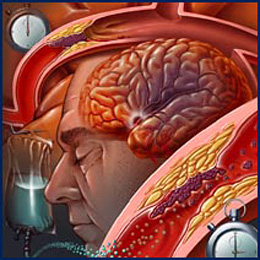 |
 |
 |
 Health & Beauty | August 2006 Health & Beauty | August 2006  
Mexican-Americans at Higher Risk for Second Stroke
 HealthDay HealthDay


| | Ischemic strokes, which comprise about 90 percent of strokes, are caused by a blockage in an artery. |
Mexican-Americans who've suffered a stroke are 57 percent more likely than non-Hispanic whites to suffer a second stroke, researchers report.

The finding adds to the results of a 1998 study that found that Puerto-Rican American stroke patients face three times the risk of a second stroke as white stroke patients do.

"We found that Mexican-Americans have a higher stroke recurrence risk, but we still don't exactly know why that is," said study author Lynda D. Lisabeth, an assistant professor in the department of epidemiology at the University of Michigan School of Public Health in Ann Arbor.

Lisabeth and her colleagues noted that, compared with a single stroke, recurrent strokes were associated with poorer patient outcomes and an increased risk of death.

Reporting in the September issue of the Annals of Neurology, the authors remarked that 700,000 Americans experience a stroke each year, and for 200,000 of them it's a recurrent event.

Prior estimates had put the average risk for experiencing a second stroke within 30 days of a first incident at between two percent and four percent. That risk rose to between seven percent and 13 percent over the course of a year.

In their four-year study, Lisabeth and her team identified all cases of ischemic stroke occurring among adults over the age of 45 in an urban county of more than 310,000 people located in southeast Texas. Mexican-Americans made up more than half the county's population.

Ischemic strokes, which comprise about 90 percent of strokes, are caused by a blockage in an artery.

Of a total of 1,345 stroke cases tallied, 118 patients went on to suffer a second ischemic stroke. Mexican-Americans accounted for 76 of those recurrences, and had a 57 percent higher risk for stroke recurrence compared to non-Hispanic whites, adjusting for other risk factors.

Having a second stroke nearly tripled the risk of death, compared to patients who experienced just one stroke, the researchers found. This added risk did not differ by ethnicity, however.

In fact, Mexican-American stroke patients appeared to have somewhat better survival rate than non-Hispanic whites, regardless of how many strokes they suffered.

"There are interesting differences, and we need to better understand them," said Lisabeth. "So, now we're exploring some of the social determinants of health to see if they have an influence - things like religion, and beliefs about fatalism, depression, spirituality."

Other potential factors include "the patient's underlying disease pathology, the medications used, and compliance with prescriptions for conditions like high blood pressure and high cholesterol, as well as genetic factors," Lisabeth said. "All of these can perhaps play a role. But at this point, it's all speculation."

But another expert offered up a different reason.

"Secondary strokes are almost always related to the persistence of high blood pressure and the persistence of diabetes, and half of the Mexican-Americans in the study had diabetes, while only 22 percent of the non-Hispanics had diabetes," noted Dr. Norman M. Kaplan, a clinical professor in the division of hypertension at the University of Texas Southwestern Medical Center at Dallas.

"This fact clearly puts the Mexican-American patients at a much higher degree of risk for any vascular trouble," he said.

Other factors may play a role, Kaplan said.

"These results are not unexpected, because I work in a largely Hispanic area, and I know that Mexican-Americans do not get the medical care that other population groups do," Kaplan added. "In part, it may be cultural: A lot of people in Mexico believe in healers, and there's a lot of folk medicine which doesn't work as far as controlling blood pressure. But an even bigger part of it is certainly poverty, because if you look at any poor population, they're going to get less medical attention. So, we have to look at a wide range of things."

For more on stroke risk, visit the American Stroke Association. | 
 | |
 |



